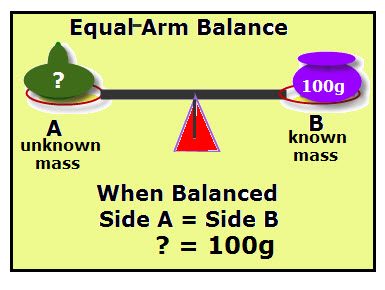 Matter is anything that has mass and takes up space.
Matter is anything that has mass and takes up space.
Mass is defined as the amount of matter that an object is made of.
YIKES! Matter has mass and mass is made of matter! This doesn’t tell me what these terms mean.
UUM!! For now, let’s say that mass is the amount of STUFF that an object is made of.
For example, in the diagram of the equal-arm balance, Objects are placed on each pan of the balance. On the left side (A) , the mass of the green object is unknown. On the right side (B), the mass of the purple object is known and its marked as 100 g.
This measuring tool is balanced when the arm is parallel to the ground. When balanced, the mass of the objects on each pan are equal. For this diagram, the unknown mass is equal to 100g.
NOTE: The arms on each side of the balancing point (middle where red triangle touches) are equal.
Discover for Yourself
You can make an equal-arm balance using common materials. For example, in the diagram a ruler is used for the arm of the balance. To the ruler, using string, paper cups are hung. The cups are the pans of the balance where objects are placed.
 For the diagram, coins are used as the known masses. You could use pennies or other objects, such as paper clips. First you need to determine the mass of one coin. To do this, use a food scale to determine the mass of 20 or more coins. Then, divide the measured mass of the 20 coins by 2o. This gives you the mass of one coin.
For the diagram, coins are used as the known masses. You could use pennies or other objects, such as paper clips. First you need to determine the mass of one coin. To do this, use a food scale to determine the mass of 20 or more coins. Then, divide the measured mass of the 20 coins by 2o. This gives you the mass of one coin.
Place the object with an unknown mass in one cup and start adding coins to the other cup until the ruler is balanced (parallel with the floor).
Multiply the number of coins times the mass of one coin–VOILA’– You have the mass of the object.
 |
Chemistry For Every Kid |